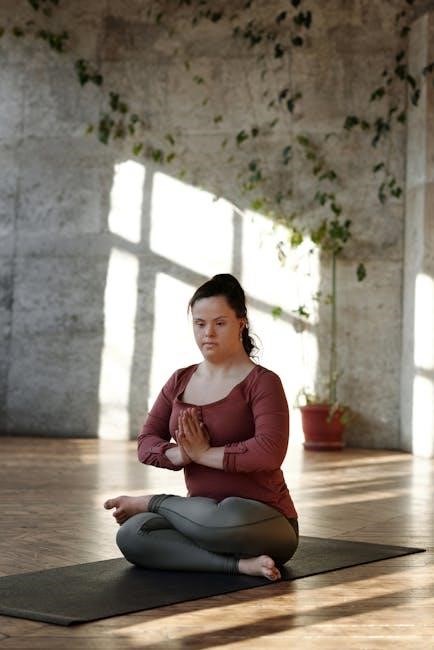
Lower Cross Syndrome is a common postural disorder characterized by muscle imbalances in the lower body, often due to poor posture and sedentary lifestyles. It primarily affects the hip flexors and lower back muscles, leading to discomfort and limited mobility. Addressing this condition requires a combination of strengthening, stretching, and posture correction exercises to restore proper alignment and function.
Understanding the Basics
Lower Cross Syndrome involves muscle imbalances in the lower body, typically caused by prolonged sitting or poor posture. It is characterized by tight, overactive hip flexors and weak, inhibited abdominal muscles. This imbalance often leads to a forward pelvic tilt, putting strain on the lower back. Over time, this can result in chronic pain, poor mobility, and limited functional movement. Addressing the condition requires a focus on strengthening the core and glutes while stretching the hip flexors and hamstrings. Understanding these fundamental muscle dynamics is essential for developing effective exercise routines to correct the syndrome and restore proper posture and movement patterns.

Prevalence and Importance
Lower Cross Syndrome is a common condition, particularly among individuals with sedentary lifestyles or those who spend extended periods sitting. It is often seen in office workers, drivers, and athletes with poor training habits. The syndrome’s prevalence highlights its significance, as untreated cases can lead to chronic lower back pain, limited mobility, and increased risk of injury. Addressing Lower Cross Syndrome is crucial for maintaining proper posture, enhancing athletic performance, and improving overall quality of life. Early intervention through targeted exercises and lifestyle changes can prevent long-term musculoskeletal issues, making it a key focus for both prevention and rehabilitation strategies.

Causes and Risk Factors
Lower Cross Syndrome often results from sedentary lifestyles, poor posture, and muscle imbalances, leading to tight hip flexors and weak abdominals, which exacerbate lower back pain.
Muscle Imbalances
Muscle imbalances are a primary cause of Lower Cross Syndrome, characterized by tight, overactive hip flexors and hamstrings, coupled with weak, underactive abdominal and gluteal muscles. This imbalance disrupts proper movement patterns, leading to poor posture and increased strain on the lower back. Prolonged sitting, lack of exercise, or repetitive movements can exacerbate these imbalances. Weak core muscles fail to stabilize the pelvis and spine, while tight hip flexors pull the pelvis into an anterior tilt, creating a domino effect of misalignment. Addressing these muscle imbalances is crucial for effective management and prevention of the syndrome. Strengthening and stretching exercises target these specific muscle groups to restore balance and functionality.
Poor Posture
Poor posture significantly contributes to Lower Cross Syndrome by altering the natural alignment of the spine and pelvis. When the body adopts an abnormal posture, such as an anterior pelvic tilt or excessive lordosis, it places additional strain on the lower back muscles. This misalignment leads to overactivity in the hip flexors and hamstrings, while weakening the core and gluteal muscles. Over time, this can result in chronic discomfort, poor movement mechanics, and an increased risk of injury. Addressing poor posture through corrective exercises and awareness is essential to managing and preventing the progression of Lower Cross Syndrome. Proper postural habits help restore balance and reduce muscle tension.
Sedentary Lifestyle
A sedentary lifestyle is a key contributor to Lower Cross Syndrome, as prolonged periods of inactivity disrupt muscle balance. Sitting for extended durations weakens the glutes and core muscles while tightening the hip flexors and hamstrings. This muscle imbalance leads to poor posture and movement patterns, increasing the risk of lower back pain and dysfunction. Regular physical activity is essential to counteract the effects of sedentary behavior. Incorporating exercises that strengthen the glutes and improve core stability can help restore proper muscle function and reduce symptoms; Addressing a sedentary lifestyle through movement and exercise is crucial for managing and preventing Lower Cross Syndrome effectively.

Symptoms and Diagnosis
Lower Cross Syndrome often presents with lower back pain, tight hip flexors, weak glutes, and poor posture. Diagnosis involves physical exams and movement assessments to identify muscle imbalances and postural distortions.

Common Symptoms
Lower Cross Syndrome often manifests with lower back pain, tightness in the hip flexors, and weakness in the glutes. Individuals may experience poor posture, such as an anterior pelvic tilt, leading to a swayback appearance. Pain or discomfort during activities like standing, bending, or lifting is common. Some people may also notice difficulty maintaining proper posture or feel stiffness in the hips and lower back. Over time, these imbalances can contribute to chronic pain and limited mobility, making everyday movements challenging. Early recognition of these symptoms is crucial for effective management and prevention of further complications.
Diagnosis Methods
Diagnosing Lower Cross Syndrome typically involves a combination of physical assessments and movement evaluations. A healthcare professional may perform a posture analysis to identify abnormal alignment, such as an anterior pelvic tilt or excessive lumbar lordosis. Muscle strength and flexibility tests are conducted to detect imbalances, particularly weak glutes and tight hip flexors. Palpation may be used to check for muscle tension or tenderness. Range of motion assessments and functional movement screens can reveal limitations or pain during specific actions. While imaging like X-rays or MRIs isn’t always necessary, they may be used to rule out structural issues. A comprehensive evaluation ensures an accurate diagnosis and appropriate treatment plan.
Relationship with Upper Cross Syndrome
Lower Cross Syndrome often co-occurs with Upper Cross Syndrome due to overlapping muscle imbalances and postural dysfunctions. Both syndromes frequently appear together, requiring integrated treatment approaches for optimal relief.
Comparing Both Syndromes
Lower Cross Syndrome (LCS) and Upper Cross Syndrome (UCS) share similarities as both are posture-related muscle imbalance patterns. However, LCS primarily affects the lower body, while UCS impacts the upper body. LCS involves tight hip flexors and weak glutes, whereas UCS is characterized by tight chest and shoulder muscles with weak scapular stabilizers. Both syndromes often coexist, exacerbating postural distortions and discomfort. Understanding their differences is crucial for targeted exercises and treatments. Addressing one without the other may lead to incomplete recovery, highlighting the need for a comprehensive approach to restore overall posture and function.
Co-Occurrence and Impact

Lower Cross Syndrome (LCS) often co-occurs with Upper Cross Syndrome (UCS), creating a complex postural distortion. This combination exacerbates muscle imbalances, leading to increased pain and limited mobility. The tight hip flexors and weak glutes in LCS can worsen the forward head posture and rounded shoulders seen in UCS. This dual dysfunction puts additional strain on the spine and joints, potentially causing chronic pain and movement inefficiency. Addressing both syndromes simultaneously is essential for effective treatment, as neglecting one may hinder recovery and prolong discomfort. A comprehensive approach ensures better outcomes and reduces the risk of further postural degradation.
Strengthening Exercises
Strengthening exercises for Lower Cross Syndrome focus on activating weak muscles like glutes and abdominals. Glute bridges and deadlifts target these areas, improving posture and reducing pain.
Glute Bridges
Glute bridges are an effective exercise for addressing Lower Cross Syndrome by targeting the gluteus maximus and hamstrings. Lie on your back with knees bent and feet flat. Engage your core, lift your hips toward the ceiling, and squeeze your glutes at the top. Slowly lower back down to the starting position. This movement strengthens weak glute muscles and improves pelvic alignment. Perform 3 sets of 12-15 repetitions for optimal results. Proper form is essential to avoid strain and maximize benefits. Regular glute bridges can enhance posture, reduce pain, and improve overall lower body stability.
Deadlifts
Deadlifts are a powerful exercise for addressing Lower Cross Syndrome, targeting the glutes, hamstrings, and lower back muscles. Stand with feet shoulder-width apart, engage your core, and lift a weight or barbell by hinging at the hips. Keep the back straight and push through the heels. This exercise strengthens the posterior chain, countering muscle imbalances caused by the syndrome. Proper form is crucial to avoid injury. Perform 3 sets of 8-12 repetitions, focusing on controlled movements. Deadlifts improve pelvic alignment, enhance posture, and restore muscle balance, making them a key component in managing Lower Cross Syndrome effectively.
Lunges
Lunges are an effective exercise for addressing Lower Cross Syndrome, targeting the glutes, hamstrings, and core muscles. Stand tall, take a large step forward, and lower your body until both knees are bent at 90 degrees. Keep your back straight, engage your core, and push through your front heel to return to the starting position. This exercise helps strengthen weakened glutes and hamstrings, improving posture and reducing muscle imbalances. Perform 3 sets of 10-15 repetitions on each leg. Proper form is essential to avoid injury. Lunges enhance hip stability, alleviate lower back pain, and promote better pelvic alignment, making them a valuable addition to your routine.
Stretching Exercises
Stretching exercises improve flexibility and reduce muscle tension, targeting tight hip flexors and hamstrings. Regular stretching enhances posture correction and alleviates Lower Cross Syndrome symptoms effectively always.
Hip Flexor Stretches
Hip flexor stretches target tight muscles in the hip flexor region, crucial for addressing Lower Cross Syndrome. These exercises improve hip mobility and reduce muscle imbalances caused by prolonged sitting or poor posture. Common stretches include the kneeling hip flexor stretch and standing hip flexor stretch, which focus on the iliopsoas and quadriceps. Perform these stretches 2-3 times weekly, holding each for 20-30 seconds to maximize flexibility. Proper form is essential to avoid strain and ensure effectiveness. Regular hip flexor stretching can alleviate anterior pelvic tilt and strengthen posterior chain muscles, promoting better posture and movement patterns. Consistency is key to long-term benefits.
Hamstring Stretches
Hamstring stretches are essential for addressing tightness and imbalances in the posterior chain, often associated with Lower Cross Syndrome. Tight hamstrings can pull the pelvis posteriorly, exacerbating the condition. Effective stretches include the standing hamstring stretch and seated hamstring stretch, which target the hamstrings and calf muscles. Perform these stretches 2-3 times weekly, holding each for 20-30 seconds. Proper form involves keeping the knees straight and avoiding rounding the back. Regular stretching improves flexibility, reduces muscle tension, and supports proper pelvic alignment. Incorporating hamstring stretches into a routine can help alleviate symptoms and enhance overall lower body mobility. Consistency is vital for long-term relief and prevention;

Core Stability
Core stability is crucial for maintaining proper posture and movement patterns, addressing muscle imbalances linked to Lower Cross Syndrome. Strengthening the core enhances pelvic and spinal alignment, improving overall stability and reducing discomfort. A strong core provides a solid foundation for functional movements and helps prevent further postural deviations. Incorporating core-strengthening exercises into a routine is essential for long-term management and relief from Lower Cross Syndrome symptoms. Consistent practice promotes better body mechanics and reduces the risk of recurrence. A stable core is key to restoring balance and optimal physical function.
Plank Variations
Plank variations are effective exercises for improving core stability, essential for addressing Lower Cross Syndrome. They strengthen the abdominals, obliques, and lower back muscles, enhancing spinal and pelvic alignment. Front planks target the rectus abdominis, while side planks engage the obliques. Alternating arm or leg movements add complexity, improving balance and engagement. Proper form is crucial to avoid strain and maximize benefits. Incorporating plank variations into a routine helps restore core strength, reducing muscle imbalances associated with Lower Cross Syndrome. Consistent practice improves posture, reduces discomfort, and enhances overall stability, making planks a key component in managing and preventing the condition.
Bird-Dog Exercise
The Bird-Dog Exercise is an effective core stability exercise that targets the abdominals, lower back, and glutes, beneficial for addressing Lower Cross Syndrome. By improving pelvic and spinal stability, it helps correct muscle imbalances. To perform, start on all fours, engage the core, and extend one arm and the opposite leg while maintaining a neutral spine. Hold for a few seconds before returning to the starting position. This exercise enhances posture and reduces discomfort. Proper form is essential to avoid strain and maximize benefits, making it a valuable addition to routines aimed at managing Lower Cross Syndrome.
Posture Correction
Posture correction is crucial for addressing Lower Cross Syndrome, focusing on proper spinal alignment and core engagement to reduce muscle imbalances and improve overall stability effectively.
Proper Posture Techniques
Proper posture techniques focus on aligning the body to reduce strain on muscles and joints. For Lower Cross Syndrome, emphasize standing or sitting tall with shoulders back and pelvis in neutral position. Engage core muscles to support the lower back and maintain a gentle lumbar curve. Avoid slouching or tilting hips forward, which can worsen muscle imbalances. Regular practice of posture-awareness exercises, such as shoulder rolls and pelvic tilts, helps reinforce proper alignment. Using ergonomic furniture and reminders to adjust posture throughout the day can also promote long-term improvement. Consistency is key to breaking poor habits and preventing further progression of Lower Cross Syndrome.
Exercises for Postural Awareness

Exercises for postural awareness help individuals recognize and correct improper alignment. The cat-cow stretch improves spinal mobility by alternating between arching and rounding the back; Pelvic tilts target the lower back muscles, enhancing awareness of pelvic positioning. Shoulder blade squeezes strengthen the muscles between the shoulder blades, promoting better posture. The bird-dog exercise enhances core stability and posture by engaging the arms, legs, and torso. These exercises should be performed slowly, focusing on proper form, and held for 5-10 seconds; Repeat 8-12 times for optimal results. Regular practice improves body awareness and reduces the risk of muscle imbalances associated with Lower Cross Syndrome.

Prevention and Lifestyle Changes
Preventing Lower Cross Syndrome involves maintaining an active lifestyle, incorporating regular stretching, and ensuring proper ergonomics in daily activities. Strengthening core and glute muscles is essential.
Ergonomic Adjustments
Ergonomic adjustments play a crucial role in preventing Lower Cross Syndrome. Ensure your workspace is set up to promote proper posture, with your chair height adjusted to keep feet flat on the floor and knees at hip level. Monitor height should align with eye level, and keyboards and mice should be positioned to avoid reaching forward. Regularly remind yourself to stand up and stretch every 30-60 minutes to reduce prolonged sitting. These simple changes can significantly reduce the strain on your lower back and hip muscles, helping to prevent the development of imbalances associated with Lower Cross Syndrome.
Lifestyle Modifications
Lifestyle modifications are essential for managing and preventing Lower Cross Syndrome. Incorporating regular physical activity, such as walking or swimming, can improve overall muscle balance and reduce sedentary behavior. Maintaining a healthy weight through a balanced diet helps alleviate pressure on the lower back and hips. Prioritizing sleep quality by using a supportive mattress and adopting proper sleeping postures can also reduce muscle strain. Limiting prolonged sitting and incorporating movement breaks throughout the day are critical. Additionally, stress management techniques, such as deep breathing or yoga, can enhance postural awareness and muscle relaxation, further supporting long-term prevention and recovery from Lower Cross Syndrome.

When to Seek Professional Help
Signs for Medical Attention
Seek professional help if experiencing severe pain, numbness, or limited mobility. Persistent symptoms despite self-care warrant medical evaluation to prevent further complications.
If experiencing severe lower back or hip pain, numbness, or tingling, seek medical help. Persistent symptoms lasting over two weeks or worsening pain despite self-care indicate professional consultation. Radiating pain down the legs or difficulty performing daily activities should prompt medical evaluation. Sudden weakness or loss of function in the lower extremities requires immediate attention. A healthcare provider can assess muscle imbalances, nerve compression, or underlying conditions. They may recommend imaging or physical therapy. Early intervention prevents chronic issues. Ignoring severe symptoms can lead to prolonged recovery or complications, making timely professional help essential for effective management of Lower Cross Syndrome.
Role of Physical Therapy
Physical therapy plays a crucial role in managing Lower Cross Syndrome by addressing muscle imbalances and improving posture. A licensed physical therapist designs personalized programs to strengthen weak muscles and stretch tight ones. They use techniques like manual therapy, exercises, and education to enhance mobility and reduce pain. Therapy focuses on restoring proper movement patterns and core stability. It also includes exercises to improve postural awareness and address lifestyle factors. A physical therapist can help prevent progression and promote long-term recovery. Regular sessions ensure sustained progress and reduce the risk of recurrence, making it an essential component of comprehensive care for Lower Cross Syndrome.